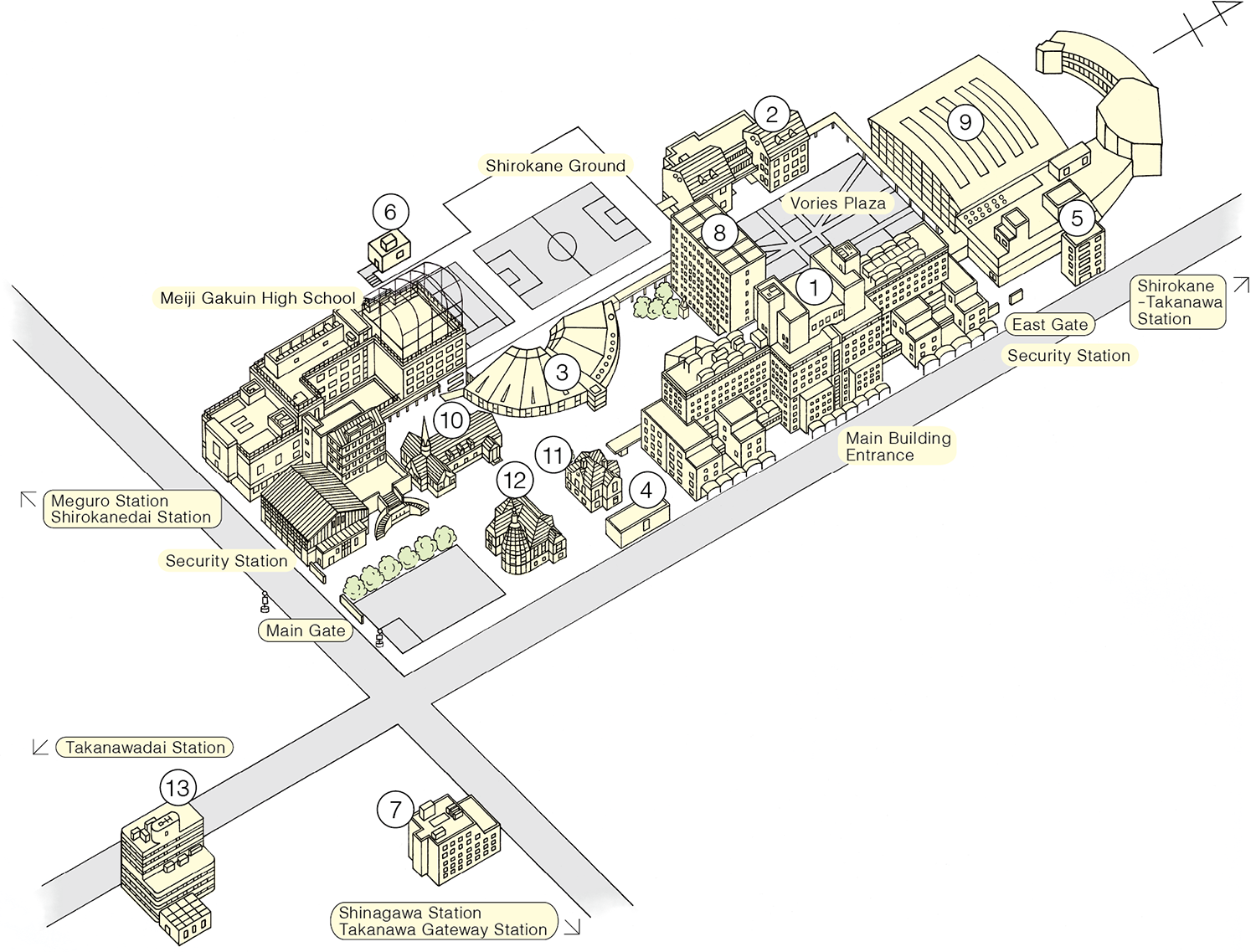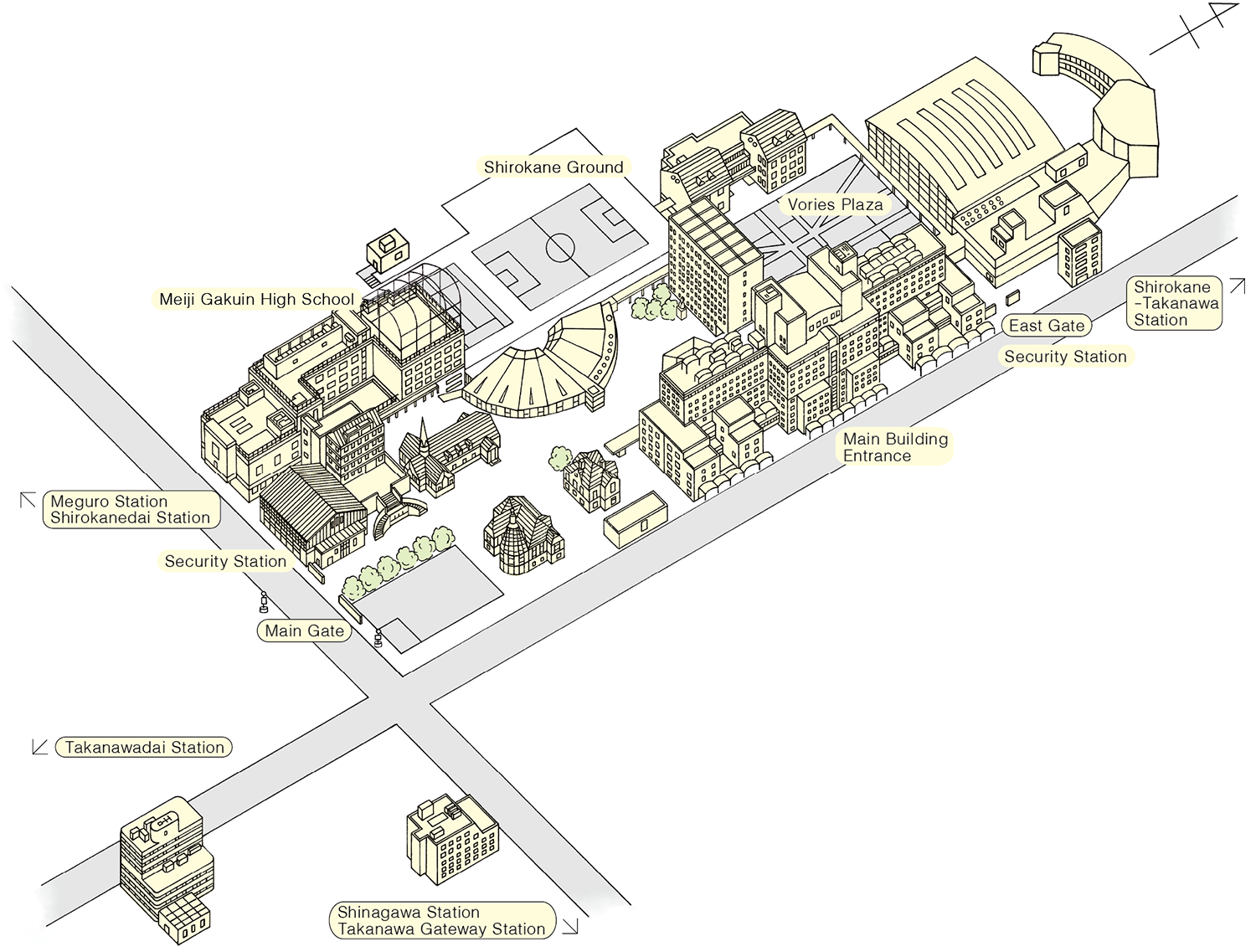Institution Guide
1 Main Building
-
This building houses classrooms, the Academic Affairs Department, the Student Affairs Department, the Career Center, The Teaching Career Services Division, and other facilities that are essential to university life.The Library is located at the center of the building, and on the seventh floor it shares space with the Toyama Kazuyuki Memorial Archives of Modern Japanese Music.




2 Building 2
-
Notable for its tile roof, this classroom building was designed on the theme of a “little chateau.” Like the Main Building, it has multi-purpose classrooms that are highly soundproofed and provided with audio-visual facilities.On the ground floor is The International Center, the Faculty of Economics Office for International Programs and the Faculty of Law Office for International Programs.




3 Building 3
-
Building 3 is a crescent-shaped classroom building. It has some large classrooms that can hold 500 people.



4 Building 10
-
On the ground floor is the Social Cooperation Division and the Volunteer Center.

5 Building 11
-
There are piano practice rooms on the first two floors.

6 Building 13
-
Building 13, which is fully covered with teak latticework on all sides, received a Good Design Award in the 2012 academic year.


7 Building 15
-
Side by side with classrooms, practice rooms, and so on, this building is home to the Psychological Clinic, which offers counseling services to members of the local community.

8 Hepburn Hall
-
Hepburn Hall is home to computer training rooms, a faculty lounge, the Graduate School, and other facilities. The building's well-designed seismic retrofitting has been covered in architectural journals.




9 Palette Zone Shirokane
-
Home to a living and culture zone for students, the building offers Co-op Shop, Cafeteria, the Iinner Courtyard with the Café, and other such places for relaxation, together with activity spaces, including the Art Hall, club rooms, and an arena.




10 Meiji Gakuin Chapel
-
Completed in 1916, this building was later extended with wings on either side. The pipe organ at the rear of the second floor was built painstakingly over 12 years using historical construction methods. (The chapel was designated the Tangible Cultural Properties of Minato City and ranked among the “Historical Landmarks Especially Important for the Landscape” by the Tokyo Metropolitan Government in the 2002 academic year.)




11 Imbrie House
-
Built around 1889, this building is one of the few remaining examples of early missionary houses in Japan and a valuable example of historical architecture. It was the residence of Dr. William Imbrie. It was restored using the same materials as the original over a two-year period starting in 1995. (Nationally designated an important cultural property, it was designated one of the city's “Historical Landmarks Especially Important for the Landscape” by the Tokyo Metropolitan Government in the 2002 academic year.)




12 Meiji Gakuin Memorial Hall
-
Built in the neo-gothic style in 1890, this building has a small chapel on the ground floor that provides a place for quiet meditation. The reed organ with a pedal keyboard was built in the 19th century and still produces an early 20th century sound in the present day. (The organ was designated the Tangible Cultural Properties of Minato City. The building was designated one of the city's “Historical Landmarks Especially Important for the Landscape” by the Tokyo Metropolitan Government in the 2002 academic year.)




13 KDX Takanawadai Building
-
The Alumni Center and the Meiji Gakuin Alumni Association occupy offices on the second floor of this building.




 Main Building
Main Building Building 2
Building 2 Building 3
Building 3 Building 10
Building 10 Building 11
Building 11 Building 13
Building 13 Building 15
Building 15 Hepburn Hall
Hepburn Hall Palette Zone Shirokane
Palette Zone Shirokane Meiji Gakuin Chapel
Meiji Gakuin Chapel Imbrie House
Imbrie House Meiji Gakuin Memorial Hall
Meiji Gakuin Memorial Hall KDX Takanawadai Building
KDX Takanawadai Building